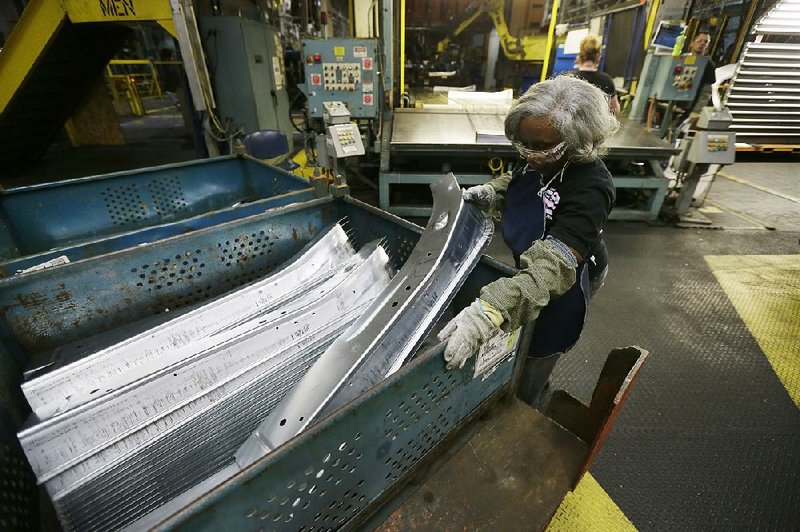WASHINGTON -- A plunge in energy-related drilling and sluggish manufacturing sent U.S. industrial output down for a fifth-straight month in April.
Overall industrial production slid 0.3 percent in April after a drop of the same size in March, the Federal Reserve said Friday. The figures suggest that weakness in manufacturing and mining is weighing heavily on the economy.
But the effects of setbacks in the first quarter, including bad weather and a West Coast port dispute, will probably fade, analysts said, signaling the industry could make some progress in coming months.
"The manufacturing picture is really pretty flat," said David Sloan, senior economist at 4Cast Inc. in New York, who correctly projected the drop in overall production. As oil prices rebound and the negative effects of the ports dispute fade, manufacturing "will go from flat to modest growth, but I wouldn't count on strong growth," he said.
Oil and gas well drilling plunged 14.5 percent last month, its fourth-straight double-digit decline. Last year's steep decline in oil prices, from about $110 a barrel to $50 in January, has forced energy producers to rapidly scale back operations.
Manufacturing output was unchanged after rising 0.3 percent in March. Utility production fell 1.3 percent, as Americans used less heat but haven't yet cranked up the air conditioning.
The cutbacks by energy companies likely contributed to a drop in the production of industrial machinery, which fell 0.9 percent, its second-straight decline. The strong dollar also likely held back machinery sales, because it makes goods more expensive overseas. Companies such as Caterpillar are exporting fewer trucks, bulldozers and other industrial machines.
The data "reflects the continued head winds the U.S. manufacturing sector faces from a strong dollar, lower oil prices and softness in international demand," Jesse Hurwitz, an economist at Barclays, said.
Auto production rose 1.3 percent, a solid increase but down from March's 4.3 percent gain.
A separate report Friday showed U.S. manufacturers are slowly adjusting to the challenges of a strong dollar and low oil prices.
The Federal Reserve Bank of New York said its Empire State manufacturing index rose to a plus 3.09 reading in May, up from a negative 1.19 reading in April. The index was lifted by the first increase in new orders in four months.
The Empire State index provides an early look at U.S. manufacturing each month, and May's reading is a sign that manufacturing could be starting to recover.
In the first three months of the year, industrial production fell at a 0.7 percent annual rate, the worst quarterly showing since the second quarter of 2009 when the economy was mired in recession. Manufacturing output also fell 1 percent in the first quarter.
In addition to less drilling by energy companies, the sharp fall in new wells has led to weaker demand for steel pipe and other manufactured goods such as rail cars and transport oil.
Those factors contributed to a very weak showing for the economy in the first three months of the year, when most analysts expect that it contracted by as much as 1 percent at an annual rate.
Still, economists think manufacturing should recover later this year once the effect of oil and gas cutbacks has faded. The dollar's value has leveled off, so that drag also should fade. Yet few analysts see manufacturing helping the economy much this year.
In a third report Friday, the University of Michigan said consumer confidence unexpectedly fell in May by the most in more than two years as Americans' views on the economy dimmed.
The index of consumer sentiment dropped to 88.6, the lowest since October, from 95.9 in April. The 7.3-point decrease was the largest since December 2012.
News that the world's largest economy stalled last quarter shook Americans' outlook, while the rise in fuel costs since early March also contributed to the gloomier perceptions. While slightly lower than in the previous month, households still held relatively upbeat views on incomes, a sign spending will be sustained.
"The decline was widespread among all age and income subgroups as well as across all regions of the country," Richard Curtin, director of the Michigan Survey of Consumers, said in a statement. "To be sure, the recent decline in consumer confidence does not indicate an incipient downturn in consumption and residential investment. Rather the data indicate a reluctant acceptance on the part of consumers that economic growth will remain near the same lackluster pace recorded during the past several years."
The index has shown bigger declines than in May in only 20 months since the monthly surveys began in 1978.
Information for this article was contributed by Christopher S. Rugaber of The Associated Press and by Shobhana Chandra, Jordan Yadoo, Nina Glinski and Michelle Jamrisko of Bloomberg News.
Business on 05/16/2015
